Thriller
James Bond triple bill
So, from the exciting introduction to the Bond universe that Dr No provided, I moved along (chronologically, of course) to a trio of films that pretty much embody what James Bond is. These films are the very peak of ‘Bond-ness’, they’re so jam packed with all the exciting (and ridiculous) tropes that came to define the the Bond film as a series that it’s no surprise that Austin Powers found the vast majority of its material here - some of the scenes are almost shot-for-shot identical!

From Russia With Love (1963 / Terrence Young / Sean Connery)
Goldfinger (1964 / Guy Hamilton / Sean Connery)
Thunderball (1965 / Terrence Young / Sean Connery)
Both From Russia With Love and Thunderball feature Spectre plots for our heroic agent to battle, whilst Goldfinger is much more of a one-man villain. From Russia takes us from the early form of Dr No and ramps it up by throwing a whole lot more excitement at it. Bond now has some serious gadgetry (albeit relatively basic) and his quick-assembly sniper rifle is particularly useful. We also meet some of the most fabulously English of scenes - the foreign spy on the train who gives himself away by drinking red wine with fish! What a mistake! Sean Connery, as ever, is fabulous throughout but I couldn’t help feeling that, whilst From Russia threw an awful lot of exciting elements at the plot, the structure of the story itself was slightly lacklustre. Like Dr No, it had it’s peaks and a few very memorable moments but as a film it was certainly lacking something.
Goldfinger, easily one of the very best of Bond, takes all the elements that From Russia contained and turned them up a bit. Rosa Klebb’s killer shoe becomes Oddjob’s killer hat, a comparatively timid attempt to steal a code-machine becomes an audacious plot to irradiate all of America’s gold, etc. etc. Goldfinger turns the heat up - and possibly overdoes it. Here then, we find lasers! gadget cars! sprayed gas! an implausibly strong Korean! and all sorts of other madness.
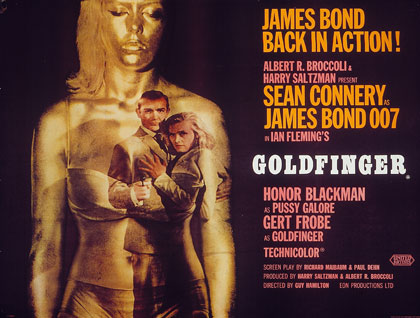
I’d call it a film of hits and misses: when it gets it right, it gets it very right indeed… but occasionally it’s not quite so strong. A prefect example of the latter would be the extended Bond vs. Goldfinger golf showdown. I’ll repeat that: golf. I mean, whoever thought to set a dramatic encounter over a (long) game of golf? When we’ve been teased with bullet-proof cars and tear-gas briefcases, an elaborate ball-swapping plot that centres on Bond’s recognition of the Slazenger 5 golf ball is… boring.
That said, some of the scenes are undeniable classics. The sight of Bond, strapped to a chunk of metal with a high-power metal-cutting laser edging ever closer towards painful emasculation is as unforgettable as James Bond films get. It would be sublime even without dialogue but the now classic exchange “Do you expect me to talk / No Mr Bond, I expect you to die” is so wonderfully blunt that it just makes the scene perfect.
The only thing, to my mind, that really stands in the way of Goldfinger being the absolutely perfect Bond film is the utterly ridiculous names used throughout. So Goldfinger likes gold? And his first name is Auric? Like the element? And his odd job man is er… called OddJob? And the major plan to contaminate Fort Knox is called Operation GrandSlam? And the sex-interest woman is called Pussy Galore? All this and more: Goldfinger is about as subtle as a sledgehammer. Whilst I’d never demand a thoughtful or challenging Bond film, Goldfinger does occasionally feel like it’s treating us like idiots. I had absolutely understood that the sexy woman would have sex with Bond without her being named Pussy Galore (suitably mocked by Austin Powers’ Alotta Fagina). It’s, sadly, the kind of choice that makes this film feel so dated - even more than its two predecessors.

The last time I saw Thunderball - where we’re back with Spectre and have a plot of nuclear-ransom - was before the Austin Powers films; it’s hard to watch it in the same way now. We get scenes in the Spectre lair with ’number one’ frying his cheating agents (whose steaming, but now empty, chairs return to the table), an eye-patched villain and a fantastic opening scene with a Spectre agent dressed as a grieving widow. Bond doesn’t actually shout “That’s a man, maaaaan!” but I could here it in my head…
As a film Thunderball is the most coherent and elaborately plotted yet but (for all that I teased Goldfinger) it lacks some of the more outrageous fun. There’s no decent villain - eyepatch man does little besides giving grumpy orders - but there are some decent scenes (chase scene through the carnival!) and it does hang together as a pretty decent film. Sadly, there are far too many dull action sequences for it to be a true classic… Underwater scenes galore here and none of them are much fun. Some stirring music isn’t enough to save a long, slow, flippers-and-wetsuits harpoon-battle snooze of a scene in what ought to be the most exciting part of the film.
Despite some flaws in each, these three Bond films are a pretty exciting triple-bill of action fun and, taking over where Dr No left off, make a convincing case for crowning Sean Connery as best Bond ever. From here, there’s only one more Connery-Bond left before we come to George Lazenby’s disasterous effort…
Repulsion and Happy People
Three Two more from the Film Festival! Something old, something new, and something informative…
[Bellflower was going to be included in this group… It’ll be coming soon instead…]
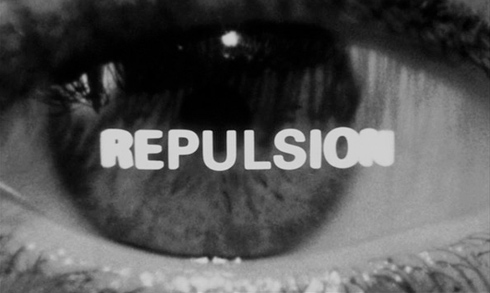
Repulsion
Repulsion is early Polanski and definitely ‘classic’ enough that it’d usually fall way outside the focus of this blog: I tend to lean away from writing about the classics, if only because plenty of people have already written plenty of words about these films - what’s left for me to add? So I’ll be brief…
[There are a couple of nice reviews to be found at Korova Theatre and Radiator Heaven]
Repulsion is a thriller in the old, almost forgotten sense of the world. It thrills. Every single person watching jumped at least once in the film, as poor Carol’s hallucinatory nightmare threw shocks and scares at her in fits and starts. Polanski throws in a wonderful mix of the increasingly repulsive - an uncooked rabbit left out to gather flies and rot - the imaginatively uneasy - a crack in the wall that threatens repeatedly to burst apart - and the threat of real violence - sexually aggressive men pounce at Carol from every corner, some real, some imaginary. It’s edge of the seat stuff that is propelled by a pulsing score and a camera that hovers voyeuristically around doorways and windowframes, beckoning the viewer into Carol’s paranoid fears.
So little of her condition or the realities or origins of her fears is explained that you leave the cinema desperately untangling plot elements in your head, guessing and re-guessing which of the more plausible elements were imagined and which of the more outlandish were real. Great stuff.
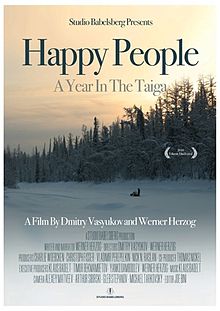
Happy People - A Year in the Taiga
This documentary of Siberian life came with a “Narrated by Werner Herzog” tagline - surely as good a guarantee of an interesting film as there can be. Thankfully, it doesn’t disappoint. We are taken, in a fairly straight-forward manner, through a calendar year in the lives of the trappers/hunters of a a Siberian village in the Taiga. Herzog contributes, as you might imagine if you’ve seen his (fabulous) Encounters at the End of the World, some perfectly dead-pan humour and a fair bit of admiration for the trappers. Occasionally, his wistful reminders that, out in the wilderness, they are free of government, free of taxes, free of bureaucracy, etc. etc. is a little too heavy-handed, but for the most part, his narration fits the documentary well.
Far more impressive than anything Herzog can provide are the demonstrations of traditional skills (especially the making of skis and the hollowing of a dug-out canoe), the rugged philosophy of the trappers and, above all, the sheer beauty of the landscape. The rive they live by and hunt around is an enormous sheet of ice for most of the year and comes slowly to life around May, looking something like a glacier rolling down a valley but much, much faster, carrying enormous chunks of ice as it flows. For the next couple of months it’s navigable by boat, but after that it turns back to ice and becomes the domain of the snow-mobile. Happy People is a fabulous watch and, although occasionally too sentimental, it’s a fascinating window into lifestyles we rarely see.
Watching James Bond films. All of them. In order.
So… this week I’ve taken on a new and exciting challenge: I’m going to watch all the James Bond films, ever single one, in the order they were made. Now, I’m not a complete masochist so I’m not going to set any kind of time limit on this: I’m not watching all 22 (twenty two!) back-to-back! I’ll take it nice and slow; I’ll put on the tux, shake my vodka martini and then relax and watch Bond, SPECTRE and all manner of exciting things.
Dr. No (1962 / Terence Young / Sean Connery)

And what better place to start than at the beginning? Dr. No, the film that started it all, is still a decent litle thriller by today’s standards. It’s packed to the brim with awesome and very memorable moments - Ursula Andress emerging from the sea! - and it cracks along at a decent pace, with attempted spider-aided assassination, fist-fights and car-chases. It doesn’t have some of the classic elements we came to associate with later Bond films - gadgetry is decidedly thin here - but it does a lot of what you’d expect from a Bond film and does it well.
Sean Connery lays down a serious argument for his place as Best Bond Ever with his brilliantly suave performance, whether flirting in the casino or punching SPECTRE agents in the head - leaving the bloodied, dead agent in the car for the valet to deal with! There’s no evil henchman on show (although sometimes that’s a good thing) but Dr. No himself with his EVIL METAL HANDS is charismatically evil, a perfect villain.
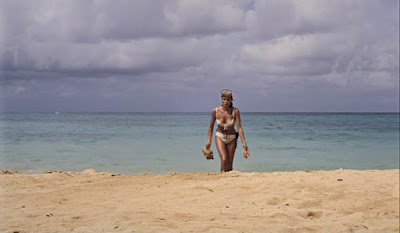
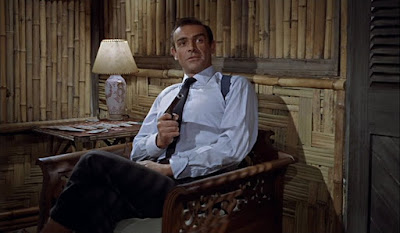
The unavoidable criticism of the film, sadly, is that the ending just isn’t very good. After such a decent story and some brilliant scenes, Bond and Dr. No’s fight in what appears to be a climbing frame over the er… yellow-lit toxic bubbling water of death is really pretty lacklustre. Having built him up as a booming-voiced overseer, a metal-clawed monster, a smooth-talking SPECTRE agent, Dr. No’s ignoble exit into the - oh so terrifying! - bubbling water is a complete let down really. Still, at least they make up for it a bit by blowing up the base… We all like a good explosion!
It’s a good film, great fun to watch and, in many respects, just what you want from a James Bond film. But it’s not perfect. Right, on with the list…. From Russia With Love next.

Cat O' Nine Tails
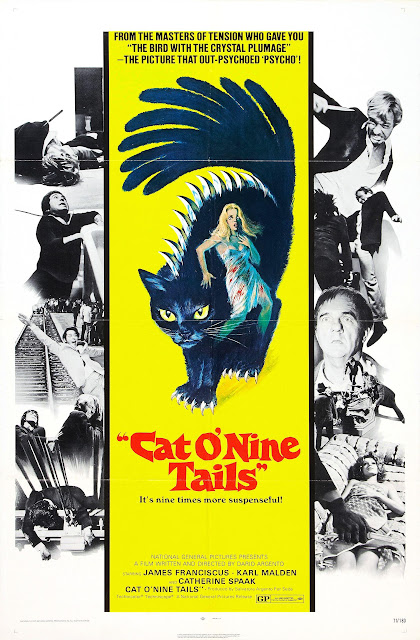
So here we are! Last night’s film, which was number 7 and brought my week of Argento films (before Suspiria tonight) to a close, was Cat O’ Nine Tails, another one that I hadn’t seen before. I was, I must say, pleasantly surprised. It falls, again, into the giallo camp more than the horror side - although they all show elements of both - and, being another very early film I must admit I didn’t expect as much fun as I got.
Several online reviews - especially those from Argento fans - are really quite negative about this film, describing it as a fairly ham-fisted follow up to Bird with the Crystal Plumage, but I couldn’t agree less. The story telling here was tight and interesting, the dialogue was er… no more clunky than we might expect and the characters and motivations were interesting.
Having watched it the day after watching Profondo Rosso, it was all too easy to see this as a blueprint for the later, more superior murder thriller; many of the aspects that were to become Argento staples are still in nascent form here. The camera is subjective and active but… not as intelligently so as in later films (some of the camera angles here seem less surprisingly wonderful and more just ‘different’), the music is absolutely instrumental (no pun intended…) in the creation of a dens atmosphere but never quite matches the iconic heights of later films - it definitely isn’t particularly memorable - the plot is full of red-herrings and hidden clues but the denouement is nowhere near as satisfying as later Argento, particularly Profondo Rosso.
It would be certainly true to call this one of the least “Argento-esque” Argento film but that’s not necessarily a bad point. I’d suggest that the film stands up pretty well on its own merits and, if the ending is perhaps a little rushed, is definitely an enjoyable watch. It’s a film that’s perhaps best recommended to those who aren’t as keen on the more flamboyantly visuals of the later films, or to those keen to see where those visuals came from. It’s certainly not perfect but it’s far from the weak slasher I had been lead to expect.
The Black Windmill
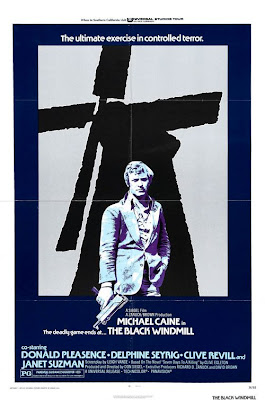
Many of the films I watch can be sorted into three categoraries - there’s big, well known films (there doesn’t seem much point writing about these, there are a million film blogs outs there…), there are the criminally ignored (the ones that really should be seen by everyone but just aren’t) and then the comically bad (the weird, the low-budget and the badly directed).
Black Windmill falls into none of these categories really. It’s not very well know, it probably doesn’t deserve much greater recognition and it’s not too bad. But not too good. So just…. you know….ok?

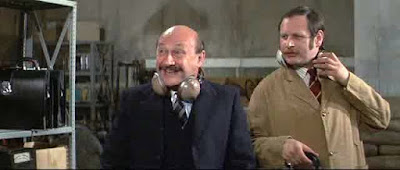
Sometimes though, an ok film is just fine. This is well acted (Michael Caine AND Donald Pleasence!), it has a vaguely engaging story and no major problems. Sadly it’s just npwhere near as gripping as it should be.
The plot meanders along; Michael Caine is a British spy, a baddie kidnaps his son in an attempt to blackmail diamonds from the British government, things all go a bit wrong from there. It’s all well written, with twists and turns in the story - hell, if you swapped the ‘diamonds’ for a dirty bomb or nuclear weapon you’d basically have the plot of a generic episode of Spooks!

Maybe though, that’s the problem. THe material here would probably work in a tightly edited hour-long tv episode but, clocking in at 1h40, this crawls along; the surprises aren’t surprising enough and the baddies aren’t bad enough. Ho hum.
But wait! It has got Michael Caine AND Donald Pleasence in it! All is not lost. Watch it if you’re bored; if you give up halfway through you’re probably not missing much…
(I realise that this sounds quite damning - it’s not meant to be. The film is quite good. It’s just not…. terribly exciting)
